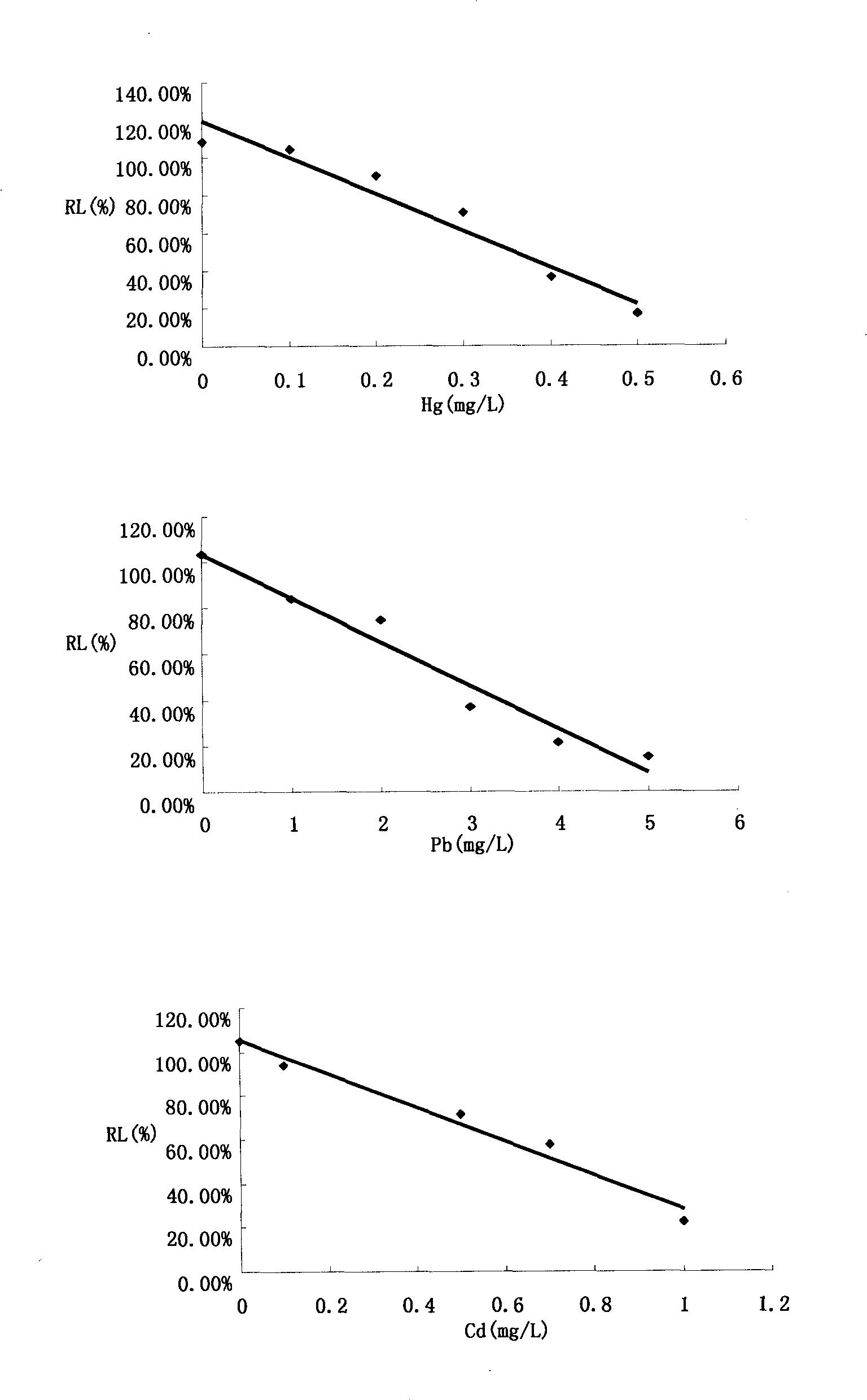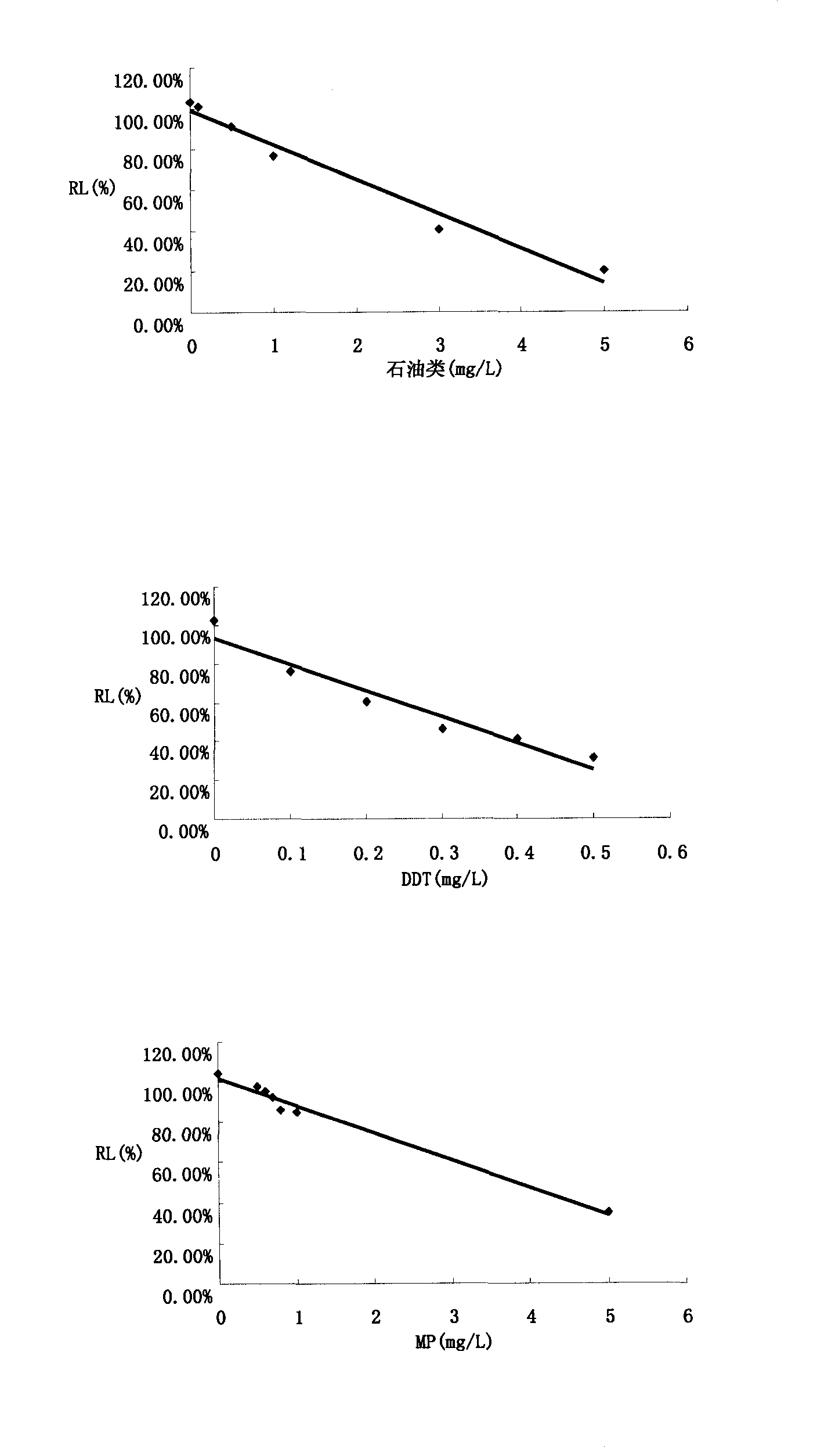Method for detecting toxicity of characteristic toxic and harmful pollutants of aquatic products
A technology for toxicity detection and pollutants, which is applied in the direction of water testing, food testing, material inspection, etc., can solve the problems of not many screening methods and insufficient basis
- Summary
- Abstract
- Description
- Claims
- Application Information
AI Technical Summary
Problems solved by technology
Method used
Image
Examples
Embodiment 1
[0020] Test the relative toxicity coefficient of different polluted environments
[0021] The specific method is as follows:
[0022] 1. Configure toxic substance solutions with different concentrations to obtain different polluted environments. The relative luminous intensity of Vibrio rascheidi in various polluted environments was determined by using the method of determining the half-lethal concentration of pollutants in a luminescent bacteria toxicity detector. The relative luminous intensity of the bacteria reflects the toxicity of each toxic substance in the polluted environment.
[0023] Taking nine pollutants of Hg, Cr, As, Pb, Cu, Cd, DDT, petroleum, and methyl parathion pesticide (MP) as examples, (there is only one toxic substance in a polluted environment, and each pollutant is Determination) set Cu concentration as 0, 0.1, 0.2, 0.3, 0.5, 1 mg / L; Pb concentration as 0, 1, 2, 3, 4, 5 mg / L; Cd concentration as 0, 0.1, 0.5, 0.7, 1mg / L; Hg concentrations are 0, 0.1,...
Embodiment 2
[0031] Test the pollution of algae products by various toxic substances
[0032] See Table 2 below for the enrichment coefficient BCF of kelp, P.
[0033] Table 2 The enrichment factor BCF of various pollutants in algae
[0034]
[0035] 1, in conjunction with the relative toxicity coefficient among the embodiment 1, judge the pollution situation of each toxic substance to sea-tangle:
[0036] The ratio of relative toxicity coefficient of Cd to BCF: 0.720 / 790=9.11×10 -4
[0037] The ratio of relative toxicity coefficient of Cu to BCF: 0.541 / 360=1.50×10 -3
[0038] The ratio of relative toxicity coefficient of Pb to BCF: 2.813 / 140=2.01×10 -2
[0039] The ratio is: CdCu>Pb
[0040] 2, in conjunction with the relative toxicity coefficient of each material among the embodiment 1, judge the pollution situation of each toxic material to subcardiac flat algae:
[0041] The ratio of relative toxicity coefficient of Cd to BCF: 0.720 / 17642.61=4.08×10 -5
[0042] The ratio o...
Embodiment 3
[0056] Test the contamination of shellfish products by various toxic substances
[0057] The enrichment factor BCF of each shellfish product is shown in Table 3 below.
[0058] Table 3 The enrichment factor BCF of various pollutants in shellfish
[0059]
[0060] The order of toxicity of each toxic substance to razor clams:
[0061] The ratio of relative toxicity coefficient of As to BCF: 4.966 / 371=0.0134
[0062] The ratio of relative toxicity coefficient of Hg to BCF: 0.358 / 429630=8.333×10 -7
[0063] The ratio of relative toxicity coefficient of Cd to BCF: 0.720 / 3679=0.0002
[0064] The ratio of relative toxicity coefficient of Pb to BCF: 2.813 / 3=0.9377
[0065] Relative toxicity coefficient of Cu to BCF ratio: 0.541 / 170=0.0032
[0066] The ratio of relative toxicity coefficient of Cr to BCF: 1.043 / 4=0.2608
[0067] The ratio is: HgCd>Cu>As>Cr>Pb
[0068] The order of toxicity of various toxic substances to cockles:
[0069] The ratio of relative toxicity coeffi...
PUM
 Login to View More
Login to View More Abstract
Description
Claims
Application Information
 Login to View More
Login to View More - R&D
- Intellectual Property
- Life Sciences
- Materials
- Tech Scout
- Unparalleled Data Quality
- Higher Quality Content
- 60% Fewer Hallucinations
Browse by: Latest US Patents, China's latest patents, Technical Efficacy Thesaurus, Application Domain, Technology Topic, Popular Technical Reports.
© 2025 PatSnap. All rights reserved.Legal|Privacy policy|Modern Slavery Act Transparency Statement|Sitemap|About US| Contact US: help@patsnap.com



